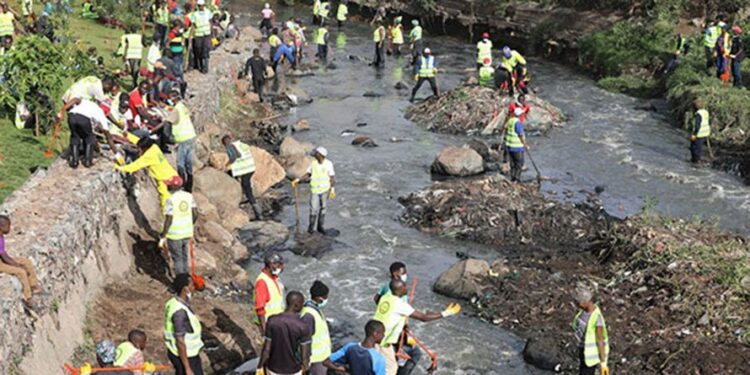Health & Fitness
Study shows Nairobi River has alarming levels of antibiotics
Monday, June 3, 2019 11:11
By NASIBO KABALE

Some of the world’s best-known rivers, including the Nairobi River, are contaminated with antibiotics that exceed levels considered to be safe in health terms.
According to a global study conducted by York University researchers, concentrations of antibiotics found in some of the world’s rivers exceed “safe” levels by up to 300 times. Sites, where antibiotics exceeded these levels by the greatest degree, were in Bangladesh, Kenya, Ghana, Pakistan, and Nigeria.
Speaking to the Business Daily, Prof Alistair Boxall, theme leader of the York Environmental Sustainability Institute, said that samples collected from the Nairobi River revealed that the most prevalent antibiotic was sulfamethoxazole.
Sulfamethoxazole is normally given in combination with Trimethoprim. The research by the York team reveals that the antibiotic, which is primarily used to treat a variety of bacterial infections including urinary tract infections, was detected at 307 of the 711 sites tested.
This is not the first time the drug has been found to be prevalent in Kenya. In joint research between the US Naval Research Laboratory (NRL), US Army Medical Research Directorate-Kenya (USAMRD-K), Kenya Medical Research Institute (Kemri), and the University of Washington in 2017, Sulfamethoxazole was discovered to be the most commonly used antibiotic in the country.
“The research found that the widespread use of tetracycline in livestock production, use of trimethoprim/sulfamethoxazole (SXT) and chloramphenicol as first-line therapeutics for typhoid, and prophylactic use of SXT in persons exposed to or infected with human immunodeficiency virus (HIV) might have contributed to the high prevalence of resistance,” the study reveals.
The findings by York University, however, explains that the Nairobi River is filled with vaccines due to the inappropriate disposal of sewage and waste dumped straight into rivers which also resulted in high antibiotic concentrations of up to 100 times safe levels.
Prof Boxall, said: “The results are quite eye-opening and worrying, demonstrating the widespread contamination of river systems around the world with antibiotic compounds.”
Prof Boxall, who presented the findings in a conference in Helsinki last week, added that the unsafe levels of antibiotics in the rivers is likely to increase the resistance to the drugs.
“The main concern is that these substances are causing an increase in antimicrobial resistance in the environment and that this resistance might be getting back to human and animal populations and contributing to the global antimicrobial resistance crisis. The substances might also be adversely affecting the ecology of the rivers,” said Prof Boxall.
Antibiotics are among the most widely used medication by human beings. They are categorised into numerous classes, according to their unique mode of action. Their side-effects are almost similar — such as nausea and vomiting. But their irrational misuse has been a source of concern.
Resistance occurs when bacteria develop mechanisms to withstand the response of the mode of action of a drug. It is evolution through natural selection, causing a mutation that is passed as a trait to the offspring of the deviant microbes, hence becoming a fully resistant generation.
Antibiotic resistance is an emerging global issue. According to the World Health Organisation (WHO), it is one of the biggest threats to global health and can affect a person of any age or race. WHO has blown the whistle over the emergence of drug-resistant bacteria that are rapidly spreading across the globe, threatening the world’s ability to treat common infectious diseases.
The UN, on the other hand, estimates that the rise in antibiotic resistance could kill 10 million people by 2050.
It notes that an increasing number of infections such as pneumonia, tuberculosis, drug poisoning, and gonorrhea are now becoming harder and sometimes impossible to treat as antibiotics become less and less effective.
Antibiotic resistance also puts the achievements of modern medicines at risk. Organ transplants, chemotherapy for cancer and life-saving surgeries will become much more dangerous without effective antibiotics to prevent and treat infections associated with these procedures.
Antimicrobial resistance in lower and middle-income countries such as Kenya is far greater than wealthy nations where prescription drugs are hard to find over the counter.
One study for example which was done in 2017 found that 90 percent of households in Kibera had used antibiotics in the previous year, compared with about 17 percent for the typical American family.
Antibiotic pollution is one of the key routes by which bacteria are able to develop resistance to the life-saving medicines, rendering them ineffective for human use.
The drugs find their way into rivers and soil via human and animal waste and leaks from wastewater treatment plants and drug manufacturing facilities. The York University research was made possible through the flying of 92 sampling kits to partners across the world who were asked to take samples from locations along their local river system. Samples were then frozen and couriered back to the University of York for testing. Some of the world’s most iconic rivers were sampled, including the Chao Phraya, Danube, Mekong, Seine, Thames, Tiber and Tigris.
An antibiotic called metronidazole took the record for the drug found in the most dangerous level at a single site, trimethoprim was the most prolific.
Ciproflaxacin, which is used to treat a number of bacterial infections, was the compound that most frequently exceeded safe levels, surpassing the safety threshold in 51 places.
The study revealed that high-risk sites were typically adjacent to wastewater treatment systems, waste or sewage dumps and in some areas of political turmoil, including the Israeli and Palestinian border.
Kenyan Business Feed is the top Kenyan Business Blog. We share news from Kenya and across the region. To contact us with any alert, please email us to [email protected]











